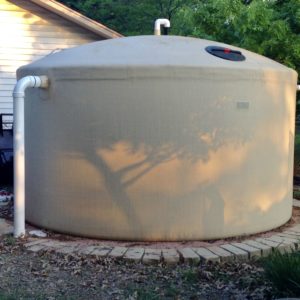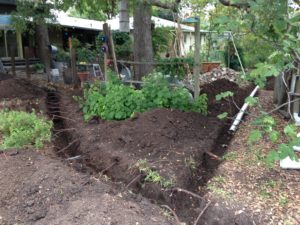Rainwater collection instead of a pool?

The newly installed 5,ooo gallon tank.
When I retired, my partner Beverly and I considered building a swimming pool. But the more we thought about a pool, the more trouble and expensive it sounded. It also didn’t seem environmentally responsible in a world that is becoming increasingly more focused on water conservation. Instead we dove headfirst into installing a rainwater collection system.
Get the biggest tank that you can afford
I consulted with experts about the scope of such a project. The collective advice was to invest in as big a rainwater collection tank as we could afford. Since we live in a central, urban neighborhood, we thought it best to go wide rather than tall. Our home has two lots. The landscape design features understories, ponds, birdbaths, and seating areas under a canopy of decades old oaks and elms. It’s basically a small urban wildlife paradise, and a perfect place to camouflage a rainwater tank!
Research applicable regulations
Our initial motivation for collecting rainwater was to utilize it for irrigating our vegetable garden. We somewhat naively thought that we could connect such a tank to our existing drip irrigation system. Conceptually it could work with the proper mechanisms in place. However, we quickly realized that there were a number of actualities that made our plan unrealistic.
First off, there is the City of Austin and its regulations. We learned of the city regulation that prohibits pumping water from one lot to another. Our project required a number of city officials to grant a variance for the water-pumping regulation. One of the holdouts required the influence of our city council representative to get his ultimate approval.
With that final flaming hoop extinguished, we then realized that the average monthly rainfall in Austin was not conducive to using rainwater in our drip irrigation system. As most of you know, rainfall in Austin is feast or famine, so the tank would sometimes be overflowing and sometimes be too low for regular watering, especially during peak growing seasons. All that said, we still recognized the value of collecting rainwater for manually irrigating our gardens and yard.
Rainwater conveyance takes planning
After researching all of the options, we decided on a fiberglass tank, primarily because of the minimal maintenance required and the longevity of the tank and fittings. We picked a 5,000-gallon tank, which is about 15.5 feet wide and 7 feet tall, that fit our budget and scale.
Holding the water, of course, is only one piece of the puzzle. You have to find a way to get the water into and then back out of the tank. We planned to collect rainwater runoff from our house, but our tank would not be close to it. Therefore, we had to find a way to get the water from the roof back to the tank. For that we hired a designer to help map out a system of underground pipes that would go from two corners of the back of the house and carport, eventually meeting before carrying the water up into the tank.

Trenches were dug to lay PVC pipe from the gutters to the rainwater tank.
We installed gutters on the four metal roof surfaces to direct the water, for a combined total of 1,370 square feet. Using rainwater collection calculators, we knew it would take about 6 inches of rain to fill the 5,000-gallon tank. For those times of deluge (e.g., Memorial Day weekends), there is an overflow at the back of the tank that flows into a PVC pipe with holes in it running along the back of our lot. That overflow helps to irrigate our neighbor’s pecan trees. For the underground pipes, we hired two very conscientious irrigation workers who hand trenched every foot, carefully avoiding almost all of the major roots from the large trees that tower overhead.
We opted for a pump
Now to get the water back out. For that we installed a Grundfos pump and built a small doghouse-sized pumphouse to protect it. This pump provides rainwater on demand to two spigots we added to the yard specifically for rainwater access. Attached are purple hoses (to indicate non-potable water) for hand watering our vegetable gardens, filling our fishponds and birdbaths, and for watering the potted plants on the patio.
A lesson learned
With one painful exception, the tank has never failed to provide adequate supplemental water, even during our longest drought periods. The one hard-earned lesson occurred when I attached a sprinkler to one of the rainwater hoses and unintentionally left it running overnight. Our large trees loved the overindulgence, I am sure, but I have never used a sprinkler since and am careful to turn off the spigots after each use.
City of Austin rebate may be available
One final notable incentive, if you still need one. The City of Austin offers a rebate for the installation of preapproved rainwater collection systems, up to a maximum lifetime total of $5,000.
Additional Resources
Rainwater Harvesting resources from Texas A&M AgriLife Extension
Weather Strategies for Austin Gardeners

Martha King joined the Travis County Master Gardeners Association in 2014 after retiring as head of endowments for the University of Texas at Austin, where she enjoyed a 30-year career. She served on the TCMGA board as secretary from 2017-2019 and has worked extensively with the Inside Austin Gardens Tour, including in her own garden as part of the 2015 tour. As a longtime urban gardener in the Crestview neighborhood, she loves nurturing her landscape of native perennials, butterfly and moth attracting vines, and towering shade trees, a favorite corner for neighbors walking by. She is also a regular volunteer at the TCMGA Plant Clinic at the Sunshine Community Gardens Plant Sale, where she loves making new friends and seeing old ones to talk about tomatoes and other plant growing challenges in Central Texas.

